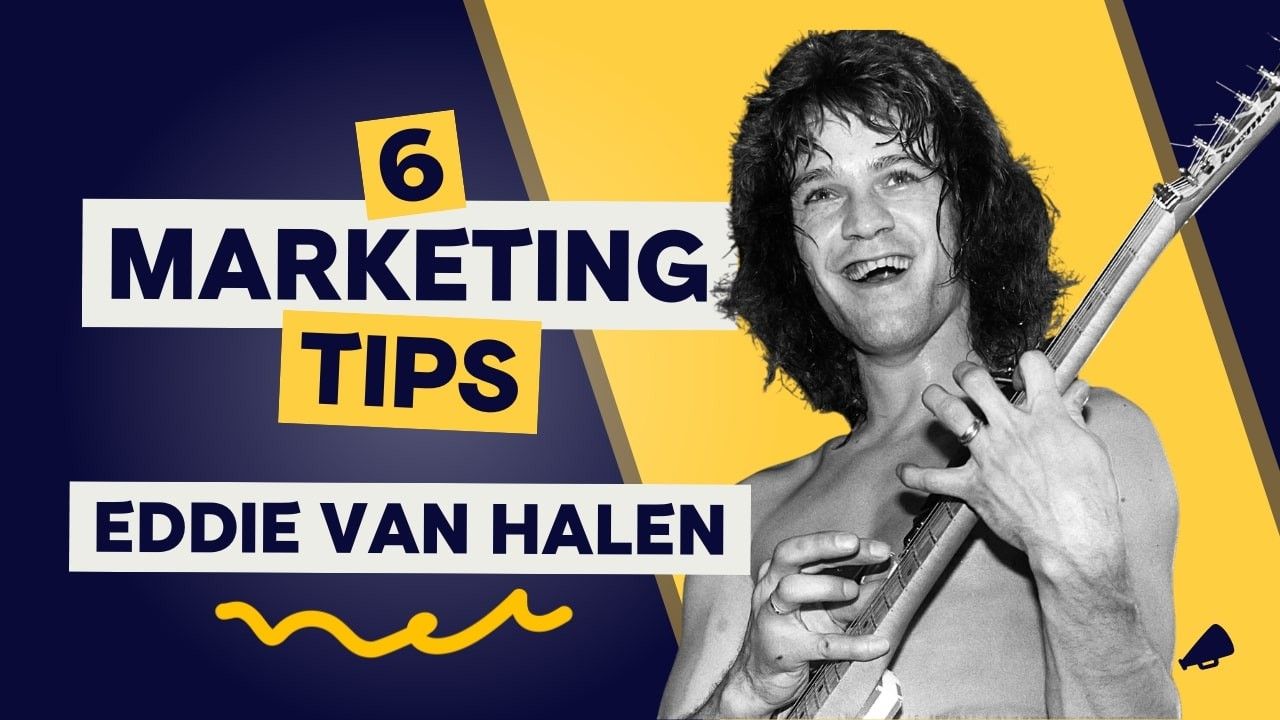(Voicebooking Guestblog)
Eddie van Halen, guitar hero and namesake of the American rock band, Van Halen, recently passed away. He will be tremendously missed by music fans all over the world, and his impact on generations of guitarists and musicians is colossal.
However, there’s a lot that marketeers can learn from Eddie and his band too. Independent communications consultant, Victor Silvis, sees various parallels between Van Halen’s work and the marketing and communications world. Ready? Let’s Jump into it!
1. Make sure you’ve got your own sound
For those who don’t happen to know who Van Halen is, we’ll start at the beginning. Eddie van Halen was born in Amsterdam and emigrated with his parents and brother Alex to a Los Angeles suburb when he was seven.
Both brothers started out playing piano. Later, Alex picked up the guitar while Eddie was on drums. When it turned out that Alex was actually the better drummer, they switched instruments.
The rest is history – And what a history! Eddie developed his own unique sound. How? By tweaking the parts of his guitar, and by overdriving his amplifiers to create plenty of distortion. The result is a warm, organic sound, which Eddie dubbed ‘brown sound’.
https://www.youtube.com/watch?v=lKmDxj1_aI0&feature=emb_logo
Youtube video: The brown sound explained
Finger tapping technique for recognisable sound
However, his playing technique is what really made his sound stand out. He would tap the guitar neck, hammering-on with two hands. You could call it drumming the guitar, a throwback to his past as a drummer.
To a big extent, it’s the technique that distinguished him as a guitarist, and it’s what gave him an unmistakable sound all his own. It only took a couple of notes for you to know – that’s Eddie.
Every brand has got to have its own ‘sound’. To get there, there are several knobs you can dial. What’s the tone of voice you’re going for? Companies like Apple, IKEA, and Virgin each have a distinct tone. That helps drive the brand’s personality home and appeal to your target audience.
2. Pick a recognisable image
Eddie’s tinkering with the technical innards of his guitars didn’t stop him from tackling the outside too. For example, he crossed his red guitar with a pretty random spread of white stripes.
That became his signature look, which predictably re-appeared on merchandise such as T-shirts, trainers, and smartphone cases. Over the years, the band made millions from it.
Brands can also benefit in spades from a strong, specific visual language. Colour, typography, illustration, and photography choices all contribute to building a strong brand. Consistency in this regard is crucial.
Picture the McDonald’s golden arches, instantly recognisable on the horizon, or consider the Apple Store aesthetic. And then there’s the green-coloured world of Heineken…
Claiming and consistently sticking to a handful of key visuals inherently associated with your brand makes a huge, positive difference.

3. Make a convincing impression
So, Eddie had a fledgeling band that proudly bore his name, but for the rest – that was it. The hard rock band Kiss had been around a good bit longer, and Gene Simmons (the bassist with the 7” tongue) saw something in Eddie’s band.
He got them to record a demo, and after knocking on countless doors, it finally ended up at Warner Bros. Van Halen had finally gotten its shot at producing their début album.
Eddie van Halen convinced the world of his talent in ‘Eruption’
‘Eruption’ is the second song on the LP and consists solely of pure, unadulterated guitar solo. Eddie drops his calling card on it, proving in a minute and 42 seconds just what this new guitar universe hero has got to offer.
It’s a true signature song. He couldn’t have done a much more convincing job of it either. The music world was blown away by all the technique, speed, and emotion.
Those are good things to consider before launching a brand or product. What’s the best aspect to feature in the spotlight? How do you do it in a way that’s never been done before? What can you own as your signature USP or feature?
https://www.youtube.com/watch?v=L9r-NxuYszg&feature=emb_logo
Youtube video: Van Halen best ever guitar solo
(Guitar solo from Eruption)
4. Radiate power
Van Halen shows were approximately two hours of pure energy explosion. Singer David Lee Roth would jump sky high and do aerial splits. Bassist Michael Anthony spun like a top.
With his wild antics behind his mega drum kit, drummer Alex van Halen was the model for The Muppet Show‘s Animal. Not to be left out, Eddie was non-stop jumping across the stage too.
If James Brown was the ‘hardest working man in show business’, then Van Halen was easily the hardest working band in the history of rock and roll. They played their asses off for you. You got what you paid for and then some.
The power on stage arced from the stage and into the audience. After seeing these guys, you stay pumped for days after. That kind of energy is what people also want to experience from a brand – whether it’s just a product that works brilliantly, a flawless service, or a powerful emotion that the brand evokes.
5. Be innovative
We already talked about Eddie’s innovative guitar sound, but that wasn’t his only innovation by a long stretch. As a band, Van Halen reinvented the genre of rock. They may have even created an entirely new genre for themselves.
Classic hard rock bands dressed in black, looked angry, and sang about hell and damnation. The songs were loud, rough, and rugged. And then came Van Halen. They were a vibrant splash of colour. And seriously…you had to love the crazy hair and those spandex tights.
They sang about love and all the other great things in life. Their rock had groove and soul. They had a sense of humour and saw rock music as entertainment. Their biggest hit, ‘Jump’, was innovative too; instead of giving the starring role to the guitar, a synthesizer took the lead.
https://www.youtube.com/watch?v=0XhKSXeT2OI&feature=emb_logo
YouTube video: What makes Van Halen’s “jump” a great song
Van Halen reinvented the rock genre
There are also examples in marketing country of brands that look beyond the confines of their niche. A holiday accommodation and an online platform joined forces to become Airbnb.
Too Good To Go uses an app to link sustainable consumers to shop produce that’s nearly passed its best-before date. Music, and all kinds of culture, actually, are the perfect inspiration for innovation.
https://www.youtube.com/watch?v=SwYN7mTi6HM&feature=emb_logo
YouTube video: Van Halen – Jump
6. Collaborate
In 1982, Michael Jackson recorded his legendary album Thriller. Quincy Jones was the producer. He called Eddie up to ask him to play the guitar solo on ‘Beat It’. Eddie thought it was a joke at first, but once he realised who he had on the line, he immediately offered to lend a hand.
Both musicians massively benefited from that collaboration. Michael Jackson got a genuine rock solo for his edgy hit, and Van Halen reached a much larger audience.
The message? Always keep your eyes peeled and ear to the ground for brands that could give your own brand a boost. Look for ways to complement each other.
Try and find unexpected, wow-factor combinations. If necessary, offer your services free of charge (that’s what Eddie did). And take the time to consider which awesome brands you’d like to team up with.
https://www.youtube.com/watch?v=VFyqSy8X1RY&feature=emb_logo
Youtube Video: Eddie Van Halen’s involvement on Michael Jackson’s beat it.
7. Expand your target group
From day one, Van Halen refused to be pigeon-holed as ‘hard rock’. Obviously, the pounding drums, thumping bass, wailing guitar, and high vocals appealed to traditional fist-pumping rock fans 100%.
And their forays into pop, e.g. the collaboration with Michael Jackson on ‘Beat It’, made it possible for the rocker to simply bring his girlfriend, who wasn’t fond of AC/DC, Motörhead, or Black Sabbath, along for the ride.
Their meticulously styled outfits also made them the boy band that all the young girls went goo-goo eyed for. Such a broad target group meant packed stadiums and towering record sales.
Van Halen refused to be pigeon-holed
Forget the sector or niche you’re in. Cast your eye past the boundaries of your target group. Who knows? There may even be more groups of people worth involving in your story.

8. Project likeability
The world’s best guitarist, the most played rock band in decades past, and assets to the tune of 100 million dollars, making him one of the richest rock musicians of all time – Eddie van Halen was on more than a few lists to be jealous of.
He had plenty of reasons to let that and his red & white striped trainers go to his head. But he didn’t. He stayed a nice, ordinary, likable guy until the very end. And he kept that big smile on his face.
Typical of any bona fide rocker, he partook of his fair share of booze and drugs, but it never turned him into a degenerate or lout. Everyone who talks about him has nothing but good things to say. I experienced it personally, as a young punk attending a Van Halen concert at the Jaap Eden Hall in Amsterdam.
We got there early in the afternoon and sneaked inside. We heard Eddie doing a soundcheck, but the stage was empty. Of course, in those days, you could already play wireless, so our hero was in the middle of the auditorium.
We walked on over to him. He stopped playing, grinned, asked if we were coming to the show that night, and readily signed our concert tickets. A seriously awesome guy.
Likeability is a powerful weapon. Just ask persuasion and influence expert Dr Robert Cialdini. He calls it ‘liking’, one of the six principles of persuasion. Voicebooking has already written a series of articles about it.
Edward Lodewijk van Halen – the world enjoyed him while he was here and will keep doing it now that he’s gone. And unknowingly, this Dutch-born talent who lived the American Dream also taught us eight great marketing lessons as a bonus. Thanks, Eddie!
This is a guest blog by Victor Silvis.
This is a guestblog by Victor Silvis. Do you want to write a guestblog as well or do you have a blog you want to share with us? Please send us an email at: [email protected]

